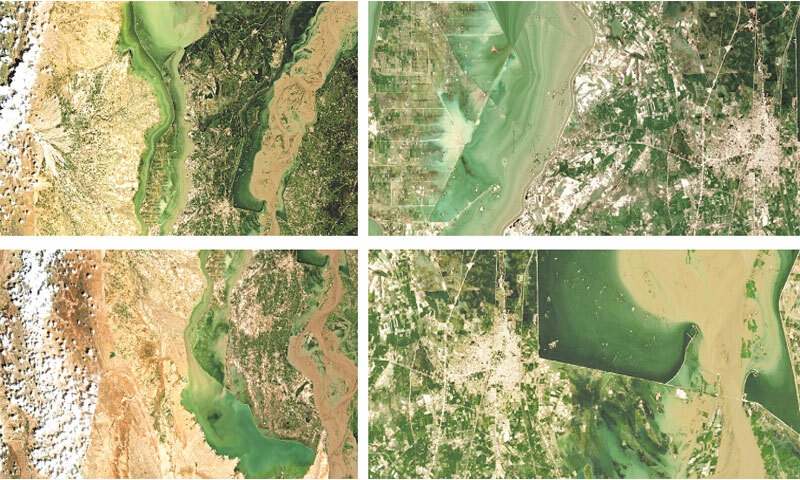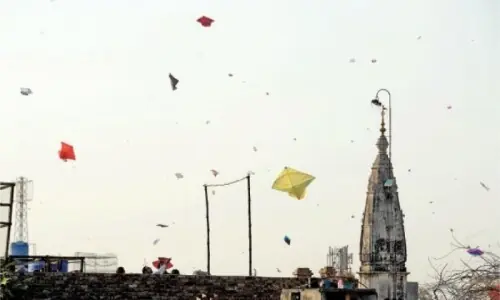• 19 people killed across country over last 24 hours
• 470 dead in Sindh, 15m displaced, 3m houses damaged; CM says province needs 2m ration bags
• Dadu water level on the rise, gushing towards Manchar Lake and Johi
DADU / KARACHI: The water level in Dadu city — surrounded on all four sides — continued to rise on Friday as the overall death toll from the devastating floods, which have affected millions across the country, crossed 1,200.
The raised level is a consequence of a surge in the flow of water down Indus river, with monstrous floods leaving a trail of destruction in the country’s northern regions.
Meanwhile, Sindh Chief Minister Murad Ali Shah told reporters the province was going through its worst floods, more destructive than even 2010 or 2011.
He said 470 people in the province had lost their lives and 1,074 were injured, besides 45,000 cattle deaths and nearly 3.17 million acres of damaged cropland. Moreover, 15m people have been displaced after 3m houses were damaged or washed away by water, which he said “is not like a car that can be steered at your will”.
Record monsoon rains and melting glaciers in northern mountains have triggered floods that have killed at least 1,208 people across the country, including 416 children, and injured 6,082, according to the National Disaster Management Authority. It said 19 casualties were reported over the past 24 hours.
The devastation is now spreading southwards, with floodwater gushing towards Manchar Lake and Johi in Dadu district on Friday.
Dadu city, the capital of its namesake district, is under water siege — with an inundated Khairpur Nathan Shah city to the north; Manchar Lake to the south; the Main Nara Valley (MNV) drain to the west; and the Indus to the east.
The MNV drain, some 8km from Dadu, is under full water pressure at its right embankment. Thousands of citizens in nearby villages of Dadu and Sehwan are braced for floods.
From the Indus river side, all eyes are on the Larkana-Sehwan (LS) embankment, some half a kilometre from Dadu city. Walidad Khushik, resident of Jan Mohammad Khushik village, said the LS water level had risen by a foot in just one day.
Irrigation official Mohammad Ibrahim said the water level was rising but he ruled out any threat, insisting that people and machinery were mobilised at the site to bring the situation under control.
As for water flows from Khairpur Nathan Shah, some 50km from Dadu and already inundated, the lifeline is Johi barrage, whose embankments were safe, according to locals.
The Manchar lake water level is also rising, Alam Rahpoto, superintendent engineer at the Sindh irrigation department, told Dawn.com, but he said all protective dykes were strong.
He said 10,000 to 15,000 cusecs were being discharged from the lake into the Indus river on Friday morning while 70,000 to 80,000 cusecs were flowing into the lake from the MNV drain and FP Bund, a flood protective dyke.
Dadu Deputy Commissioner Syed Murtaza Shah told Dawn Pakistan Army, Rangers and district administration were jointly carrying out relief work, a rescue operation was launched in kacha (riverine) areas.
Keeping in view the impending threat, hundreds of families in the province have taken refuge on roads, the only dry land in sight for many. Many are headed for urban centres, like Karachi, which has for now escaped the flooding.
“We lost our house to the rain and floods, we’re going to Karachi to our relatives. No one has come to help us,” Allah Bakash, 50, who left Dadu on Thursday with his family and belongings loaded on a truck, told Reuters news agency.
Social activist Mohammad Bux Korai said flood-affected people from Khairpur Nathan Shah, Johi and Mehar talukas have come to Dadu. An MNA in Dadu said the city had 200,000 residents. Besides, it now houses 8,000 flood-hit families, according to a survey, but the actual number could be much higher.
No imminent threat to Dadu
Meanwhile, Sindh Chief Minister Syed Murad Ali Shah on Friday said various protective dykes were under pressure and posed a threat to some major towns and cities.
He said the government was trying its best to protect various villages and towns. Still, “Abdullah Shah village, the birthplace of my father, has been flooded with the rising water in Manchhar lake,” he told a press conference at Chief Minister House, alongside Sindh Information Minister Sharjeel Memon, and advisers Murtaza Wahab and Rasool Bux Chandio.
Mr Shah said Dadu city and its urban area did not have an imminent threat of inundation, but the rural areas were 80pc per cent inundated and efforts were under way to clear them.
Besides, 85pc of Khairpur Nathan Shah was inundated. Similarly, Johi city is being defended through a ring dyke which is being constantly monitored and patrolled by locals, but its rural area is 90pc flooded.
Nasirabad and Qubo Saeed Khan are safe as the water level is receding. Besides, “over 80pc of Sukkur’s urban areas have been cleared of rainwater and the remaining will be cleared in two days,” he said.
He said 151 camps had been set up in government buildings in Sukkur, where 12,000 flood-hit people were being provided two-time meals.
In Matiari, Saeedabad is completely submerged and its four union councils were inundated.
In Larkana, up to 90pc water drained out from urban areas but about 40pc of the roads connecting to main roads were underwater, he said.
Around 35,000 people were in relief camps and 300,000 displaced people were in roadside tents and mud heaps.
Major cities cleared from rainwater included Sanghar, Tando Adam, Shandapur, Sinjhoro, Shahpur Chakur, Khipro, and Hathungo.
Relief items
Talking about the demand-supply position of different items as of Thursday, Mr Shah said that against 471,900 tents, 119,757 had been provided to 24 districts. Of the 640,700 mosquito nets needed, 503,345 have been provided. The demand for tarpaulin sheets was 183,300, of which 76,810 had been distributed.
On the whole, one million tents, three million mosquito nets, two million ration bags for two months, one million jerry cans, one million kitchen sets, 500,000 plastic mats, 500,000 woollen mattresses, and one million tarpaulins were required.
Published in Dawn, September 3rd, 2022



































